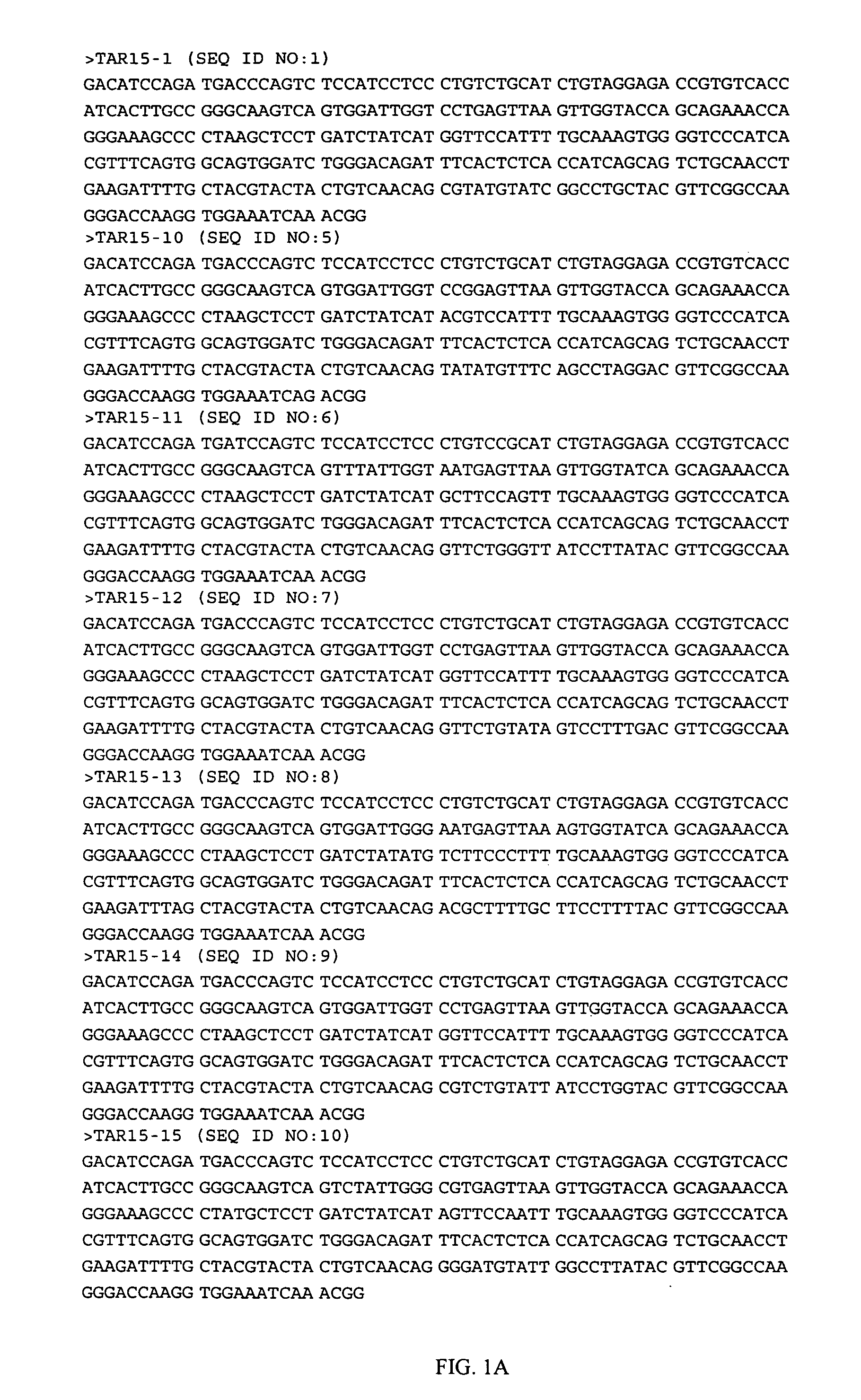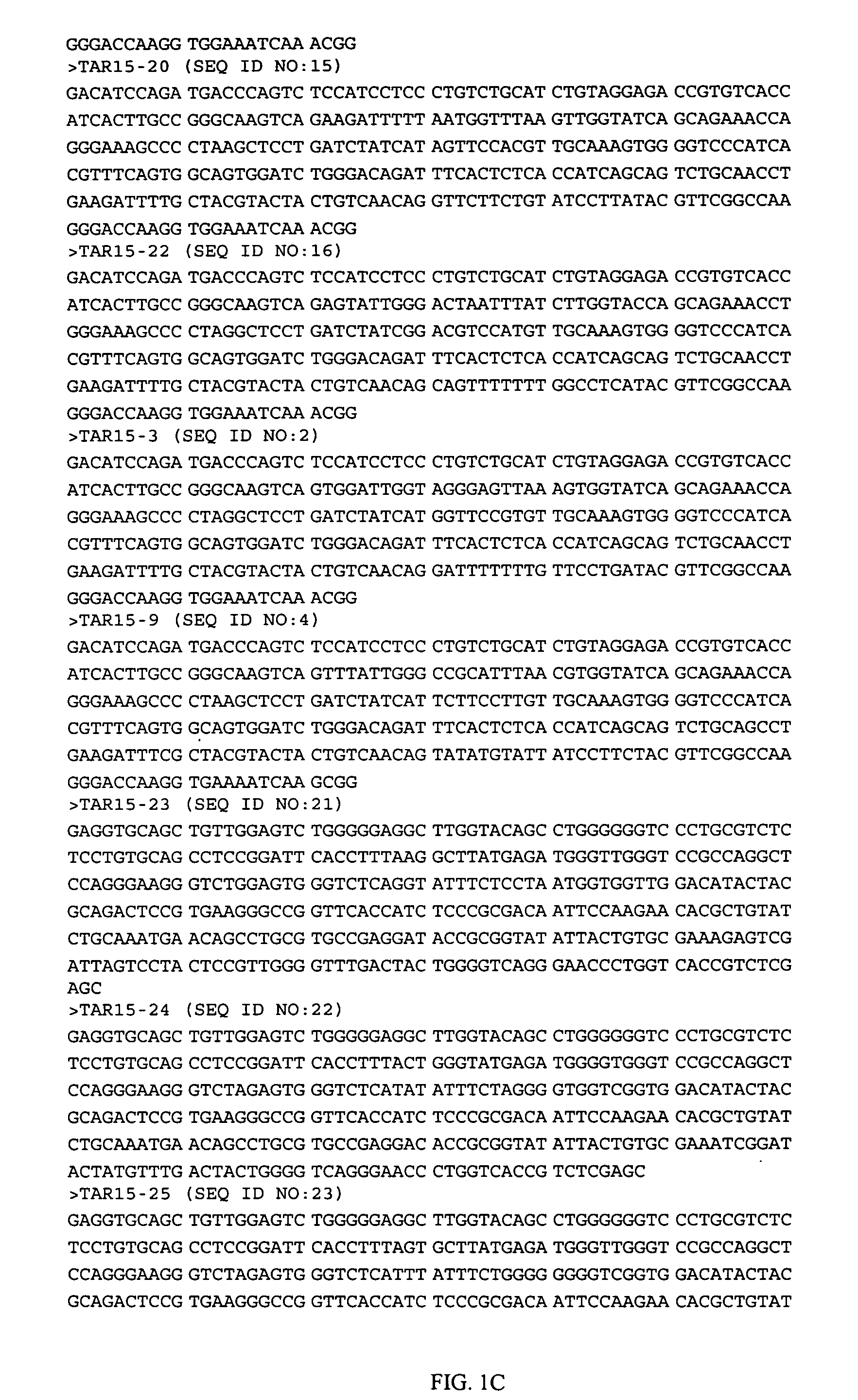Ligands that have binding specificity for VEGF and/or EGFR and methods of use therefor
a technology of ligands and specificity, applied in the field of ligands, can solve the problems of reducing the effect of ligand binding specificity, and reducing the number of ligands
- Summary
- Abstract
- Description
- Claims
- Application Information
AI Technical Summary
Benefits of technology
Problems solved by technology
Method used
Image
Examples
example 1
VEGF Receptor Binding Assays
[0337] VEGF is a specific mitogen for endothelial cells in vitro and a potent angiogenic factor in vivo, with high levels of the protein being expressed in various types of tumours. It is a 45 kDa glycoprotein that is active as a homodimer. Several isoforms have been described which occur through alternative mRNA splicing. Of these isoforms VEGF-121 and VEGF-165 appear to be the most abundant.
[0338] The specific action of VEGF on endothelial cells is mainly regulated by two types of receptor tyrosine kinases (RTK), VEGF R1 (Flt-1), and VEGF R2 (KDR / Flk-1). However, it appears that the VEGF activities such as mitogenicity, chemotaxis, and induction of morphological changes are mediated by VEGF R2, even though both receptors undergo phosphorylation upon binding of VEGF.
[0339] This method describes a VEGF receptor binding assay for measuring the ability of ligands (e.g., dAbs) to prevent binding of VEGF-165 to VEGF Receptor ...
example 2
[0360] 25 μl of ligand (e.g., dAb) were plated into a 96 well plate and then 25 ul streptavidin-Alexa Fluor (1 ug / ml) (Molecular Probes) and 25 ul A431 cells (ATCC No, CRL-1555) (8×105 / ml) were added. All reagents were prepared in PBS / 1% BSA. The plate was incubated for 30 minutes at room temperature.
[0361] Without disturbing the cells, 25 ul biotinylated EGF (Invitrogen) at 40 ng / ml was added to each well, and the plate was incubated for three hours at room temperature. Fluoresecence was measured using the AB8200 Cellular Detection System (Applied Biosystems).
[0362] Ligands (e.g., dAbs) that inhibited the binding of biotinylated EGF to EGFR expressed on A431 cells resulted in lower fluorescence counts. Wells without ligand provided a reference of the maximum fluorescence (i.e., biotinyulated EGF binding) and wells without ligand or biotinylated EGF providde a reference or the background level of fluorescence. These controls were included in all as...
example 3
IgG-Like Formats that Have Binding Specificity for VEGF and EGFR
Vectors
[0367] The pBudCE4.1 backbone (Invitrogen) was used for cloning immuno globulin constant regions, such as the IgG1 heavy chain constant region and light chain kappa constant region (see Figure * for overview). An Ig Kappa chain leader was used to facilitate secretion of the expressed protein. Ig constant regions (human IgG1 and CK) were produced by GeneArt (Germany).
[0368] The heavy chain constant region and signal peptide were cloned into pBudCE4.1 as a Hind III / BglII fragment into the HindIII / BamH I restriction sites.
[0369] The light chain constant region and signal peptide were cloned into pBudCE4.1 as a NotI / Mlu I fragment.
Cloning of dAb in IgG Vectors and Production of IgG-Like Format
[0370] VK dAb (specific to VEGF or EGFR) was cloned into IgG vector as a SalI / BsiWI fragment. VH dAb (specific to VEGF or EGFR was cloned into IgG vector as a BamHI / XhoI fragment.
[0371] The plasmid was then transfected ...
PUM
| Property | Measurement | Unit |
|---|---|---|
| Fraction | aaaaa | aaaaa |
| Volume | aaaaa | aaaaa |
| Molar density | aaaaa | aaaaa |
Abstract
Description
Claims
Application Information
 Login to View More
Login to View More - R&D
- Intellectual Property
- Life Sciences
- Materials
- Tech Scout
- Unparalleled Data Quality
- Higher Quality Content
- 60% Fewer Hallucinations
Browse by: Latest US Patents, China's latest patents, Technical Efficacy Thesaurus, Application Domain, Technology Topic, Popular Technical Reports.
© 2025 PatSnap. All rights reserved.Legal|Privacy policy|Modern Slavery Act Transparency Statement|Sitemap|About US| Contact US: help@patsnap.com



